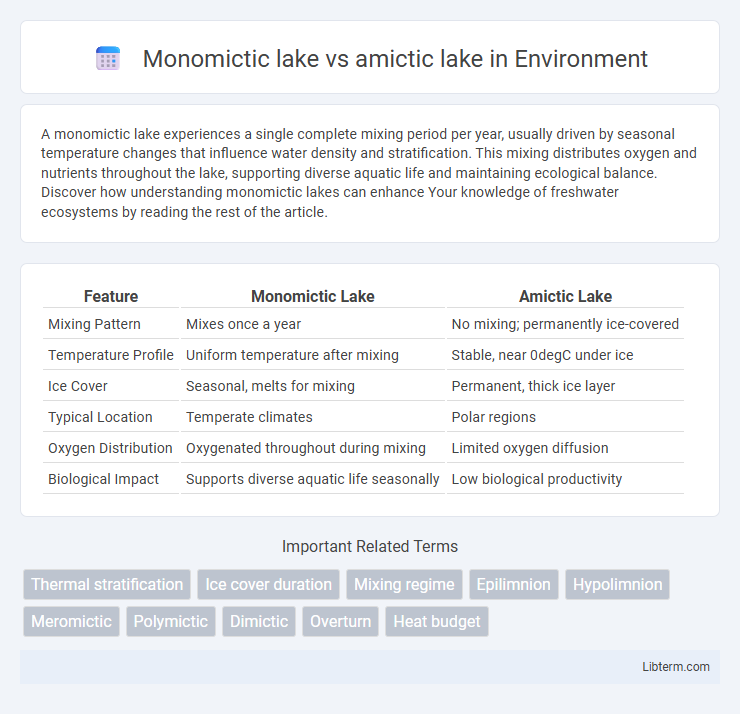A monomictic lake experiences a single complete mixing period per year, usually driven by seasonal temperature changes that influence water density and stratification. This mixing distributes oxygen and nutrients throughout the lake, supporting diverse aquatic life and maintaining ecological balance. Discover how understanding monomictic lakes can enhance Your knowledge of freshwater ecosystems by reading the rest of the article.
Table of Comparison
| Feature | Monomictic Lake | Amictic Lake |
|---|---|---|
| Mixing Pattern | Mixes once a year | No mixing; permanently ice-covered |
| Temperature Profile | Uniform temperature after mixing | Stable, near 0degC under ice |
| Ice Cover | Seasonal, melts for mixing | Permanent, thick ice layer |
| Typical Location | Temperate climates | Polar regions |
| Oxygen Distribution | Oxygenated throughout during mixing | Limited oxygen diffusion |
| Biological Impact | Supports diverse aquatic life seasonally | Low biological productivity |
Introduction to Lake Stratification
Monomictic lakes experience a single period of complete mixing annually, typically in temperate climates where surface water warms and cools distinctly, facilitating seasonal stratification and overturn. Amictic lakes, found predominantly in polar regions, remain permanently ice-covered, preventing surface water from mixing and maintaining a stable, stratified environment year-round. Understanding the contrasting stratification patterns in monomictic and amictic lakes is essential for studying nutrient cycling, oxygen distribution, and aquatic ecosystem dynamics.
Definition of Monomictic Lakes
Monomictic lakes are freshwater bodies that experience a single period of thermal stratification followed by complete mixing annually, typically in regions with moderate climates. These lakes remain unfrozen during winter, allowing one full overturn, which mixes oxygen and nutrients from the bottom to the surface. In contrast, amictic lakes are permanently ice-covered, preventing any mixing and resulting in a stable stratification year-round.
Definition of Amictic Lakes
Amictic lakes are characterized by permanent ice cover that prevents seasonal mixing of the water column, typically found in polar regions. Unlike monomictic lakes, which mix once annually due to temperature changes, amictic lakes remain stratified year-round because ice insulation stops wind-induced circulation. These lakes maintain stable thermal layers beneath the ice, influencing their oxygen and nutrient distribution significantly.
Key Differences Between Monomictic and Amictic Lakes
Monomictic lakes undergo a complete mixing cycle once per year, typically during the winter or summer months, while amictic lakes remain permanently stratified and never experience complete mixing due to persistent ice cover. Monomictic lakes exhibit seasonal temperature changes that drive the turnover process, whereas amictic lakes maintain consistently cold temperatures beneath ice, inhibiting circulation. The presence or absence of ice cover and the resulting thermal stratification patterns are the primary factors distinguishing monomictic lakes from amictic lakes.
Seasonal Mixing Patterns
Monomictic lakes undergo a single complete mixing period annually, typically during the cooler season when surface waters reach uniform temperatures with deeper layers, facilitating full water column turnover. In contrast, amictic lakes remain permanently stratified and ice-covered, preventing any seasonal mixing and confining oxygen exchange to limited surface layers or sub-ice environments. These differing mixing patterns critically influence nutrient cycling, oxygen distribution, and aquatic ecosystem dynamics within each lake type.
Temperature Profiles and Thermal Dynamics
Monomictic lakes experience a single annual mixing period driven by seasonal temperature changes, with a temperature profile that stratifies in summer and mixes completely in the cooler months, maintaining temperatures above freezing. Amictic lakes remain permanently ice-covered, preventing any mixing or thermal stratification, resulting in relatively uniform temperature profiles near 4degC beneath the ice. Thermal dynamics in monomictic lakes depend on surface temperature fluctuations and wind-induced mixing, while amictic lakes are thermally stable due to constant ice cover and lack of convective overturn.
Geographic Distribution and Examples
Monomictic lakes, found primarily in temperate and tropical regions, undergo a single annual mixing period, with Lake Michigan in North America serving as a classic example. Amictic lakes, commonly located in polar and high-altitude areas such as Antarctica's Lake Bonney, remain permanently ice-covered and do not experience typical seasonal turnover. The geographic distribution of these lakes reflects climatic influences that determine their thermal stratification and mixing patterns.
Ecological Impacts and Aquatic Life
Monomictic lakes, which experience a single annual mixing period, promote seasonal nutrient cycling that supports diverse aquatic ecosystems and fish populations by replenishing oxygen and distributing nutrients throughout the water column. Amictic lakes remain permanently stratified and frozen, limiting oxygen renewal in deeper layers and often resulting in lower biodiversity and specialized cold-adapted species. The distinct thermal and mixing regimes of these lakes directly influence oxygen availability, nutrient dynamics, and habitat conditions, shaping the structure and productivity of their aquatic communities.
Water Quality and Biogeochemical Cycles
Monomictic lakes experience a complete water turnover once annually, enhancing oxygen distribution and nutrient recycling, which supports stable water quality and promotes balanced biogeochemical cycles. Amictic lakes remain permanently ice-covered, limiting mixing and oxygen penetration, often resulting in stratified water layers with depleted oxygen in deeper zones and altered nutrient dynamics. The differences in mixing regimes between monomictic and amictic lakes strongly influence their redox conditions, organic matter decomposition, and biogeochemical transformations of carbon, nitrogen, and phosphorus.
Implications for Lake Management and Conservation
Monomictic lakes undergo a complete mixing cycle annually, influencing nutrient distribution and oxygen levels critical for aquatic life management, while amictic lakes remain permanently stratified and ice-covered, limiting gas exchange and requiring specialized conservation strategies to preserve cold-adapted species. Understanding these thermal and mixing regimes helps lake managers implement targeted measures for maintaining water quality, biodiversity, and ecosystem stability. Proper monitoring of temperature profiles and oxygen gradients enables adaptive management to mitigate impacts of climate change on these distinct lake types.
Monomictic lake Infographic

 libterm.com
libterm.com